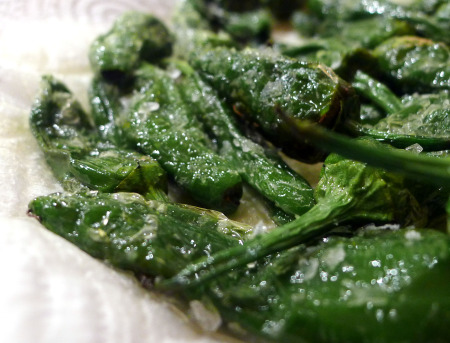padron vs. gernika

November has been freakishly warm here. I feel as if I deserve it, we deserve it, for suffering all through a rainy, cold summer and for the injustices of last winter that were forced upon us.
For this reason, only now are pimientos starting to disappear from bar countertops and grocery store shelves. Guindillas, of course, but also their fatter cousins, pimientos de Gernika. Whenever I am with an American in a bar, they call them Padrón peppers. And part of me wants to protest, say "whoa now, that's a different thing" but I've never had the factual information to back it up sufficiently (and isn't it nice to just nod, smile, and drink txakoli?). Until now.
POINT 1: Pimientos de Gernika are from, well, not exactly Gernika but from within a 50 kilometers of the Cantabrían zone. So they could be produced in Álava, but not in the lower parts, for example. They can be vareities like the Iker or Derio varieties. Why are they called Gernika then? "Gernika already had a name, known by the whole world, and plus they sell a lot of pepper at their Monday markets." -Estanis Bilbao, pepper expert from Bizkaia.
And pimientos de Padrón...you get it. From around Padrón (Galicia). Line blurs when they reach American soil, however. There, it seems, only the Padrón, or Herbón as it is more properly called, has landed. Or returned, more accurately. They were imported into Spain in the 16th century. The climate of the Cantabrian and Atlantic coast here eliminated the super hot heat from the American pepper over the years. The padrón pepper, in one of the only examples of marked differences, is slightly smaller than the Gernika pepper.
According to Bilbao the pimiento de Gernika "is green and uniform in color, with a light shine. It's between 6 and 9 cm in length, measured from end to end...The shape of the fruit is triangular, long and skinny; the apex, pointed; and the stalk, whole, thin and long. It's texture is taut, not loose, without wrinkles or symptoms of dehydration. It looks really fresh." On the palate, you can tell a pimiento de Gernika by "its texture, its fineness, its flavor. The pimiento de Gernika is different from all other peppers. It has a flavor that, once you eat it, it leave a sensation in the mouth of enjoying something very good." He says never serve it as a garnish, always as a main plate, and deep fried (after making a small slit so they don't explode in your kitchen) for less than a minute on each side. Then drain and salt.
According to Bilbao, there is a lot of fraud in the sector, with producers from Morroco selling their peppers as 'de Gernika'. These peppers are notable because they are shorter, wider and don't have the same texture or flavor.
And the major point of dispute is what makes a pepper hot. Eating both of these peppers is like russian roulette....every now and then you get a hot one. The actual ratio is around 10% hot peppers, although the longer you leave a pepper on the plant, the higher that percentage gets.
Get it? Better, I think, just to smile and drink txakoli.
